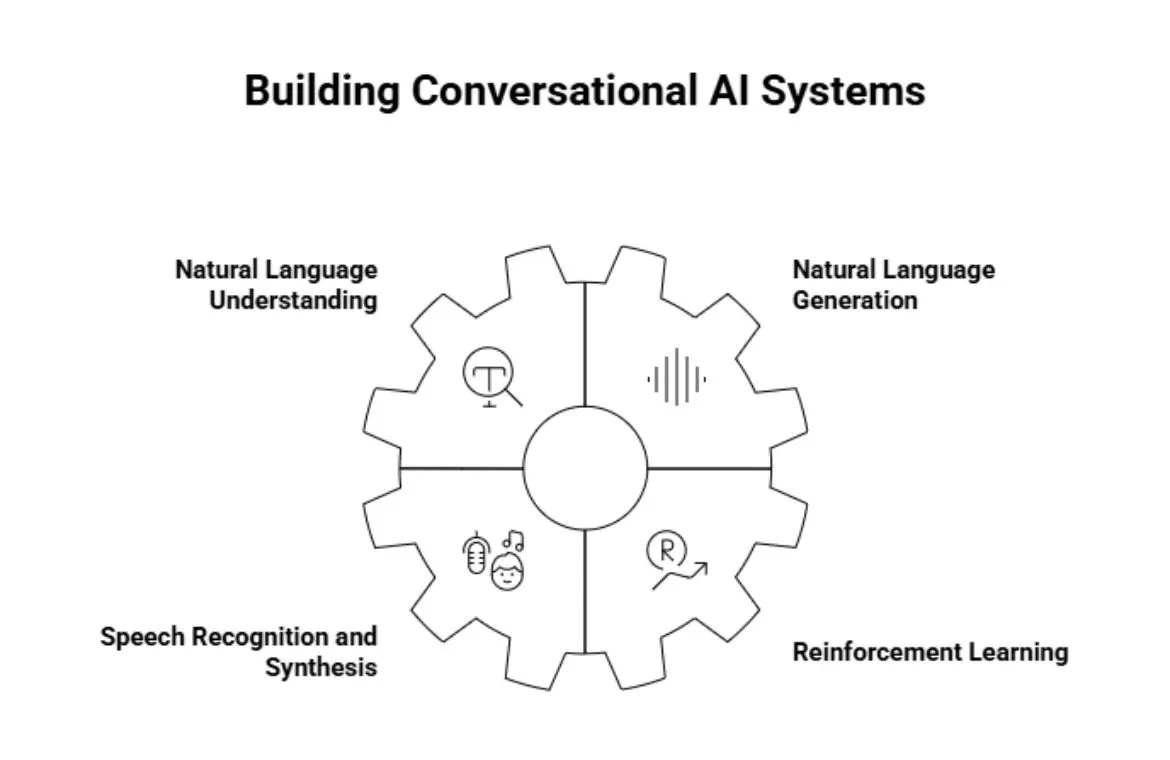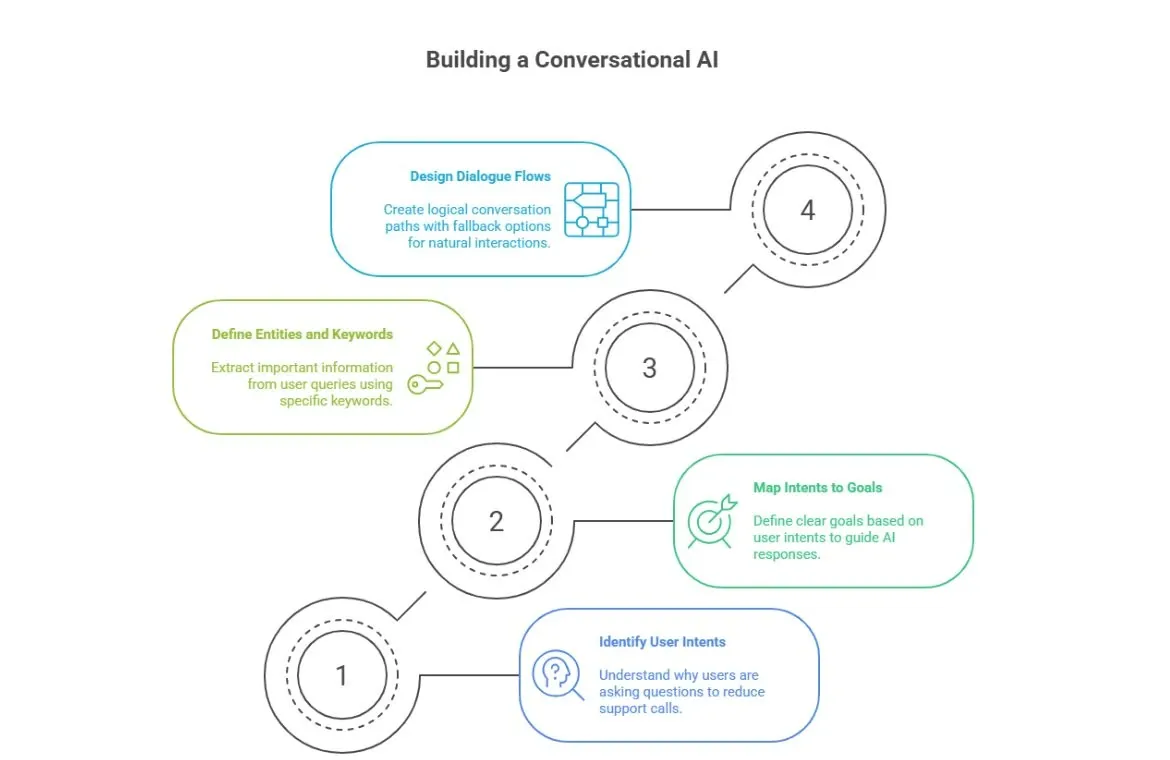Beginner’s Guide to Conversational AI

In the modern world, where numerous problems exist and a large number of people face them, Conversational AI provides a powerful way to automate tasks that humans currently handle. This reduces errors and cuts costs in business operations. Innovative technology revolutionises how organisations interact with customers and manage internal processes.
What is Conversational AI?
Conversational AI is a type of artificial intelligence that helps computers understand, process, and respond to human language naturally. The technology creates a more personal and engaging experience by tracking customer priorities and offering help 24/7 when human agents are unavailable. Modern customers now expect and want this round-the-clock support from online systems.
Conversational AI learns from real-life dialogue datasets tied to specific industries. This targeted training helps it handle customer requests better. A telecommunications customer who needs technical help will get better results from a specialised telco chatbot that knows solutions to that exact problem.
Companies use conversational AI to get more customer involvement and streamline communication. It handles many questions without needing extra staff. Customer satisfaction and efficiency improve, especially in regulated sectors like banking and healthcare.
Components of Conversational AI
A solid conversational artificial intelligence system needs four basic components. These technologies work together smoothly. They help machines understand, process and respond naturally to human language.

Natural Language Understanding (NLU)
NLU stands as the first crucial step that helps systems figure out what text input means. The technology analyses language through two main processes: intent recognition and entity recognition.
Intent recognition spots the user's goal in a message and establishes the text's meaning. Entity recognition pulls out key details about specific items mentioned.
Natural Language Generation (NLG)
NLG turns structured data into text or speech that humans can understand. Two main types exist: extractive NLG pulls exact words from source documents, while abstractive NLG creates new content based on source material.
The system works through several stages: signal analysis, data interpretation, document planning, microplanning, and surface realisation. This sophisticated process helps AI systems develop responses that feel natural and fit the context.
Speech recognition and synthesis
Speech technologies act as the voice interface in conversational systems. Speech recognition converts spoken words into digital text through complex steps, such as tokenisation and phonetic analysis. Speech synthesis does the opposite - it changes text into spoken words.
The process breaks text into individual words, assigns phonetic sounds, and groups them into prosodic units before creating audio. Modern systems like WaveNet create raw audio waveforms from scratch. They use neural networks trained on vast amounts of speech samples.
Reinforcement learning in AI systems
Reinforcement learning makes conversational AI better over time. Systems learn the best dialogue strategies through trial and error. Reward functions guide them toward successful outcomes.
The Advantage Actor-Critic (A2C) algorithm shows this process in action. It helps AI fine-tune its conversation strategies through simulated interactions. This approach enables systems to enhance their dialogue actions.
Stepping stones for building a Conversational AI
A systematic approach turns user interactions into meaningful exchanges when building a conversational AI system. Let's take a closer look at the significant steps that help create a system that understands and responds to user needs.

1. Identifying user intents
Every conversational AI begins with a clear understanding of why a consumer is asking for something. For instance, “If a customer is asking What is a conversational AI?”
That means they want to gain a basic understanding of what it really is, or they want to explore their knowledge on the subject further.
They define your end users' main concerns and help reduce support team's call volumes. Intents indicate the specific goals users want to achieve when interacting with an AI agent.
2. Mapping intents to goals
Your conversational AI tool needs clear goals based on outlined intents.
In this, the “why” comes, and “where to” is defined by what the user needs. For example, if someone asks, “Can I fly to London tomorrow?” The bot will not answer with a simple “yes.” It will directly search for flight availability and help you plan your itinerary.
Your analytics and support teams can help improve accuracy by mining web data and analysing site search queries.
3. Defining entities and keywords
Entities help pull out the important information from what users ask for or say. They work like containers holding specific values in conversations.
The nouns or keywords around your intents matter. A banking application's entities might include "username," "password," and "account number."
4. Designing dialogue flows
Simple diagrams, featuring boxes and arrows, help create meaningful dialogues. These illustrations show potential user responses and appropriate AI replies. The combination of intents and entities creates logical conversation flows.
Your AI should handle confusion gracefully with fallback options that guide users smoothly. This approach ensures natural and helpful interactions that effectively meet user needs.
Real-Life Applications and What It Means for the Future
Conversational artificial intelligence changes how organisations connect with users faster. This creates new ways to participate and streamline processes.
Conversational AI in e-commerce
Conversational AI has altered the map of retail by creating customised shopping experiences. AI-powered assistants help customers find product choices, answer questions about availability, and process orders automatically.
These systems let businesses handle thousands of customer conversations at once. Many retailers use conversational AI to track inventory. The system turns browsing into buying through smart product recommendations based on customer behaviour and priorities.
AI in education and training
Conversational AI opens up new ways to customise learning experiences. AI chatbots give quick academic support by answering questions and explaining concepts. They also suggest more resources.
For example, an AI chatbot teaches English vocabulary to students in tribal areas of Odisha by translating words into their native language and offering voice-based quizzes.
Proactive AI for user engagement
Conversational AI now predicts customer needs through immediate analytics. Smart systems spot potential issues early. This lets businesses reach out to customers before problems occur.
These systems use sentiment analysis to spot frustrated customers and respond with the right level of empathy. This has significantly improved customer satisfaction.
How it shapes the future of work
AI stands as a general-purpose technology, similar to electricity and the steam engine. It has the power to boost long-term economic growth. In spite of that, it won't affect all industries the same way. Conversational AI increases human capabilities instead of replacing jobs completely.
It handles repetitive tasks while workers focus on creative, interpersonal work. Without doubt, people will need new skills as this technology creates new job types. This applies especially to fields that need constant learning and adaptation.
Conclusion
Conversational AI sits at the forefront of human-machine interaction, transforming how businesses connect with customers. This technology processes and responds to human language while delivering tailored experiences that today's customers expect.
Natural language understanding, natural language generation, speech technologies, and reinforcement learning are the foundations of conversational AI. Unlike simple chatbots from the past, these advanced systems learn and improve with time. They become more valuable to your organisation each day.
You need careful planning to create conversational AI that works. Generative AI courses can help take a deep dive into the conversational AI solutions for the real world and create lucrative career opportunities for those who want to take this journey ahead and learn not only about how conversational AI is making an impact but also how this generative AI field is evolving faster than ever.
Because, The best systems balance technical sophistication with genuine usefulness.
In the end, conversational AI gives you a powerful tool to boost customer satisfaction, optimise operations, and prepare your business for growth in an AI-driven world.
Frequently Asked Questions
Q1. What is conversational AI?
Conversational AI is a technology that enables computers to understand, process, and respond to human language naturally, conversational AI uses natural language processing and machine learning to generate contextually appropriate replies and improve over time.
Q2. What are the key components of a conversational AI system?
The main building blocks of conversational AI include Natural Language Understanding (NLU) for interpreting user input, Natural Language Generation (NLG) for creating responses, speech recognition and synthesis for voice interactions, and reinforcement learning for continuous improvement of the system's performance.
Q3. How can businesses benefit from implementing conversational AI?
Businesses can benefit from conversational AI by providing 24/7 customer support, reducing operational costs, handling large volumes of inquiries simultaneously, improving customer engagement, and freeing up human staff to focus on more complex tasks that require empathy and critical thinking.

TalentSprint
TalentSprint is a leading deep-tech education company. It partners with esteemed academic institutions and global corporations to offer advanced learning programs in deep-tech, management, and emerging technologies. Known for its high-impact programs co-created with think tanks and experts, TalentSprint blends academic expertise with practical industry experience.



